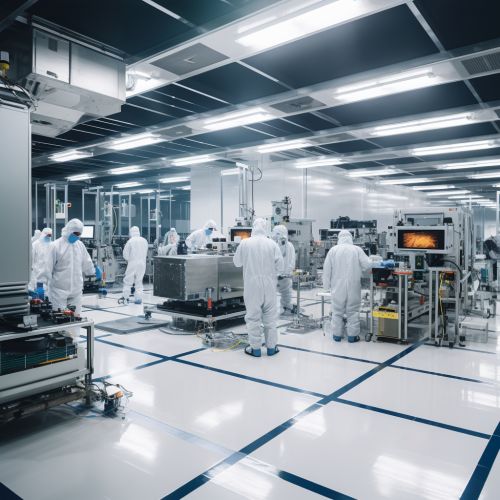Semiconductor Fabrication
Introduction
Semiconductor fabrication is the process of creating semiconductor devices, typically using photolithography. This process involves multiple steps where the electrical properties of a silicon wafer are altered to form an integrated circuit (IC).


Silicon Wafer Preparation
The fabrication process begins with the preparation of a silicon wafer. Silicon, a group IV element, is chosen due to its abundant availability and excellent semiconductor properties. The silicon is purified and melted into a cylindrical single-crystal ingot through a process known as Czochralski growth. The ingot is then sliced into thin wafers, which are polished to achieve a very flat and clean surface.
Oxidation
The next step in the process is oxidation, where the silicon wafer is heated in an oxygen-rich environment. This causes a layer of silicon dioxide to form on the surface of the wafer, which serves as an insulating layer for the semiconductor device.
Photolithography
Following oxidation, the wafer undergoes a process called photolithography. This involves coating the wafer with a light-sensitive material called photoresist. The coated wafer is then exposed to ultraviolet light through a mask that contains the pattern of the desired circuit. The exposed areas of the photoresist become soluble and can be washed away, leaving behind a patterned photoresist on the wafer.
Etching
The patterned wafer is then subjected to an etching process. This can be done either by immersing the wafer in a chemical solution (wet etching) or by bombarding it with ions (dry etching). The etching process removes the exposed areas of the silicon dioxide layer, revealing the underlying silicon wafer.
Dopant Diffusion
The next step is the diffusion of dopants. Dopants are impurities that are introduced into the silicon wafer to modify its electrical properties. This is done by heating the wafer in an environment containing the desired dopant atoms. The heat causes the dopants to diffuse into the exposed areas of the silicon wafer, altering its electrical properties.
Metallization
After the diffusion process, the wafer undergoes metallization. This involves depositing a thin layer of metal, such as aluminum or copper, onto the wafer. The metal serves as the conductive paths, or interconnects, for the integrated circuit.
Assembly and Packaging
The final steps in the semiconductor fabrication process are assembly and packaging. The wafer is cut into individual chips, each containing a complete integrated circuit. The chips are then assembled into packages that protect them from physical damage and environmental contamination. The packages also provide the electrical connections to the outside world.
Conclusion
Semiconductor fabrication is a complex and precise process that involves numerous steps. Each step is critical to the performance and reliability of the final semiconductor device. As technology continues to advance, the semiconductor fabrication process is constantly evolving to produce smaller, faster, and more efficient devices.
